
|
Monastic Journey
Continued |
|||||
Stanley Roseman
The MONASTIC LIFE
The MONASTIC LIFE
RETURNING
to
ENGLAND
to
ENGLAND
© Stanley Roseman and Ronald Davis - All Rights Reserved
Visual imagery and website content may not be reproduced in any form whatsoever.
Visual imagery and website content may not be reproduced in any form whatsoever.
At the Benedictine Abbey of Farnborough, Hampshire
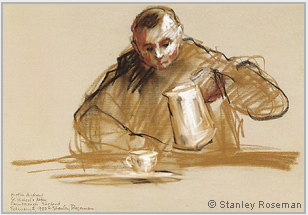
7. Brother Andrew in the Refectory, 1980
Farnborough Abbey, England
Chalks on paper, 35 x 50 cm
Musée des Beaux-Arts, Bordeaux
Farnborough Abbey, England
Chalks on paper, 35 x 50 cm
Musée des Beaux-Arts, Bordeaux
6. Travels to Sweden and Denmark
3. Historic Regions of Monasticism
in Bavaria and Swabia
in Bavaria and Swabia
Monastic Journey Continued
On the bottom of this page are links to the other pages.
2. Returning to the Netherlands
7. Convents in Piedmont
and Tuscany
and Tuscany
1. A Painting Studio
at the Abbey of La Trappe
at the Abbey of La Trappe
8. Monasteries in Old Castile
4. Returning to England
5. Sojourns in Belgium
Page 4 - Returning to England
Roseman writes of his return to Mount St Bernard Abbey in March 1984: "Brother Rufus had made his first, or 'simple,' profession the preceding April. In monasteries today, a monk having completed the customary two years as a novice makes his first vows in the presence of the abbot and community in the chapter room of the monastery. Following a time period of three to six years, the monk makes a reaffirmation of his monastic vows at a solemn ceremony in the church.
"Rufus had been an accomplished music student before entering the monastery, and the Abbot apprenticed him to Father Mark Hartley, who was an organist and a respected composer of church music. . . . In choir, Brother Rufus wore the long, white, woollen cape of a Trappist monk in first vows.''
6. Brother Rufus in Choir, 1984
Mount St. Bernard Abbey, England
Chalks on paper, 50 x 35 cm
Prentenkabinet-Kunsthistorisch
Instituut der Rijksuniversiteit,
Leiden
Mount St. Bernard Abbey, England
Chalks on paper, 50 x 35 cm
Prentenkabinet-Kunsthistorisch
Instituut der Rijksuniversiteit,
Leiden
- Father Mark Hartley, OCSO
Mount St. Bernard Abbey
Mount St. Bernard Abbey
Father Mark, the kind and caring guestmaster when the artist and his colleague first sojourned at the monastery, writes in a cordial letter in October 1998 to Roseman:
"It was warming to have your appreciative remarks about your time here. . . . It was an exciting time. Posterity will benefit from your work. . . ."
2. Brother Hugh at Vespers, 1999
Elmore Abbey, England
Chalks on paper, 50 x 35 cm
Private collection, Switzerland
Elmore Abbey, England
Chalks on paper, 50 x 35 cm
Private collection, Switzerland
Presented here is the fine drawing Brother Hugh at Vespers, 1999, (fig. 2), from Roseman's sojourn at the Anglican Benedictine Abbey of Elmore in Berkshire. Brother Hugh stands in choir, his head inclined and eyes focused on a page of the Book of Psalms that he holds.
Returning to St. Augustine's Abbey, Kent
The Boston Globe published in its Sunday magazine, 1981, an enthusiastic cover story on the first two years of Roseman and Davis' monastic journey and writes: "The measure of their acceptance can be seen in the invitation that closed the circle. While most monasteries are closed to visitors at Christmas and Easter, a private time for the monks, the abbot of St. Augustine's Abbey in Ramsgate, England, called to ask the Americans to spend Christmas with them.''
"I resumed drawing the monks in choir,'' writes the artist, "as well as in the library, the refectory, and at tea in the common room, where the monks engaged Ronald and me in lively conversation about our travels to monasteries across the Continent, behind the Iron Curtain to Hungary and Poland, to the Abbey of Subiaco in December 1978, and the following year, to monasteries in France and Spain.''
Abbot Emeritus David Parry of St. Augustine's Abbey, is seen standing in choir in the photograph, (fig. 4), 1980. The eminent abbot edited and annotated a revised English translation of the Rule of St. Benedict for the 1,500th anniversary of the saint's birth.
Roseman and Davis returned to Mount St Bernard Abbey in 1984. With a warm welcome back from the monks and their appreciation for his work, Roseman happily took up his paper and chalks and resumed drawing. From the series of excellent drawings is Brother Rufus in Choir, (fig. 6, below).
The Institute of Art History of the University of Leiden acquired the drawing of Brother Rufus in 1985 by vote of the Institute's young art historians who, along with the Keeper of Drawings, selected five of Roseman's drawings from the monasteries. The Leiden Print Room houses an important collection of master drawings from the Dutch, Flemish, German, French, and Italian schools.
At the Trappist Abbey of Mount St. Bernard, Leicestershire
Mount St. Bernard Abbey in Leicestershire was the first Trappist monastery where Roseman painted and drew at the outset of his work in 1978. From that first sojourn is the painting Father Ian, Portrait of a Trappist Monk in Meditation in the Musée Ingres, whose renowned collection grew from an important bequest by the French master Jean-Auguste-Dominique Ingres (1780-1867) to his hometown of Montauban. The Curator of the Musée Ingres, Pierre Barousse, in acquiring the Roseman portrait writes in letter: "Father Ian is for me an absolutely captivating work of art." The portrait is presented on the page "The Monastic Life.''
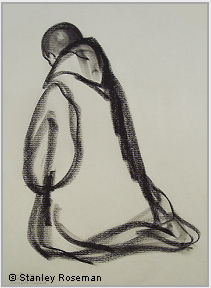
Abbot Gilbert Jones and the community warmly welcomed back the two Americans for Christmas and the New Year 1980 that commemorated the 1,500 anniversary of the birth of St. Benedict. Roseman and Davis were given their former rooms in the monk's dormitory, joined the monks for the Divine Office in church and chapel, took meals as before with the Community in the refectory, and were included again in the life of the monastery.
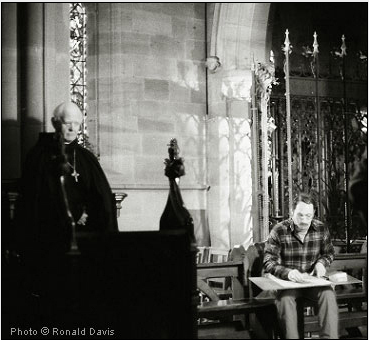
In the photograph above, Roseman is drawing in choir in the Abbey church. The neo-Gothic church was designed by the renowned English architect Augustus Welby Pugin, who is noted for the Houses of Parliament and for promoting Gothic revival architecture in the British Isles during the nineteenth century.
Roseman writes in his remembrances of his sojourns at St. Augustine's Abbey: "When the monastery bell tolled for Vespers in the late afternoon and for Compline in the evening, Ronald and I assembled with the monks in the cloister while they put on their voluminous black cowls over their black scapulas and tunics and accompanied the community through the underground passageway to the abbey church.''
Presented here is the beautiful drawing Dom Damian, A Benedictine Monk kneeling in Prayer, 1980, (fig. 5).
5. Dom Damian, A Benedictine Monk kneeling in Prayer, 1980
St. Augustine's Abbey, England
Chalks on paper, 50 x 35 cm
Private Collection
St. Augustine's Abbey, England
Chalks on paper, 50 x 35 cm
Private Collection
The figure of the kneeling monk is turned towards the high altar and seems enveloped in a cool light suggested by the gray paper. In this pyramidal composition with its pleasing geometric forms, Roseman depicts Dom Damian's voluminous black cowl in calligraphic strokes of black chalk. Variation in the strength of the line indicates the fall of light on the figure. Shaded passages accentuate the triangular shape of the hood and give rounded form to the monk's head bowed in reverence to God.
Abbot David thoughtfully inscribed a gift of his book: "To Stanley and Ronald with best wishes. May God grant you every peace and blessing. David Parry, O.S.B.''[1]
Drawing with a single chalk and an economy of line, Roseman has created a compelling image of a monk kneeling in prayer.
Please note that the website has been republished for Internet Explorer 11.
In Roseman's ongoing work on the monastic life, he drew monks in choir, the library, the scriptorium, at their workplaces, and in the refectory, as at Farnborough Abbey. The Musée des Beaux-Arts, Bordeaux, conserves the superb drawing Brother Andrew in the Refectory, 1980, (fig. 7).
With a combination of chalks on gray paper Roseman depicts the Benedictine monk seated at a table and about to pour from a white pitcher into a teacup. The pyramidal composition places the figure in the center of the page. The artist's fine modeling of the monk's face with cool highlights and warm shading is complemented by the abstraction in rendering the monk's habit with lively passages of black and bistre accented by fluent strokes of black chalk.
The Boston Globe praises Roseman's drawings as "impressive." The daily further states: "Roseman has captured the personalities of many individual monks while often managing to depict their lifestyles as well. . . . The artist's gray, brown, dark and light tones vary as subtly and surely as the monks who live out their discipline of prayer and work and meals in common."
Prior David Higham, the Superior of the Benedictine Abbey of Farnborough, in Hampshire, warmly welcomed Roseman and Davis in December 1979 and again in 1980. The Prior related to them the history of the monastery and its association with the imperial family of Napoleon III.
The Emperor, his wife, and son fled France after the fall of the Second Empire in 1870 and took refuge in England. Following the deaths of Napoleon III and the Prince Imperial, Empress Eugénie founded at Farnborough in the early 1880's a monastery dedicated to St. Michael. The abbey church contains a mausoleum with the tombs of Eugénie's husband and only son. By invitation from the Empress, the Benedictine Abbey of Solesmes, in France, sent several of its monks to establish a Benedictine community at Farnborough. Empress Eugénie died in 1920, and her tomb also lies in the crypt of the church. In the mid-twentieth century, with the increase of English monks at Farnborough, the monastery was incorporated into the Subiaco Congregation.[2]
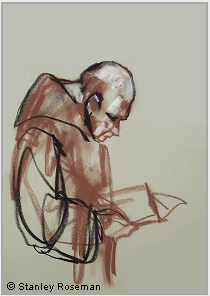
Roseman drew the figure with a harmonious combination of black and bistre chalk lines and tonal passages, with reserved areas of the gray paper, complemented by sculptural rendering of the facial features with highlights in white chalk. The effective mis-en-page brings the viewer's attention from the face of the man of advancing years to the open Psalter.
Presented here is the impressive drawing Brother Rufus in Choir. Fluent strokes of white and bistre chalks establish a strong diagonal to the composition and bring the viewer's eye to the face of the young monk who sits attentively in choir. The Trappist monk's fair complexion is complemented by his dark hair and the black scapular beneath his white cape.
With fine chiaroscuro modeling of light and shade, Roseman has rendered the distinctive facial features of Brother Rufus and a resoluteness of expression in this engaging depiction of a young Englishman dedicating himself to a monastic life.
The Keeper of Drawings Dr. Janno van Tatenhove expressed his gratitude to Davis when he brought the work to Leiden and said that Roseman's drawings are the first by an American artist acquired for the Print Room. Dr. Van Tatenhove reiterates in his cordial letter to Roseman that "until now we had no American drawings at all."
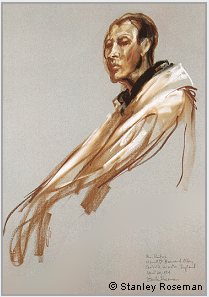
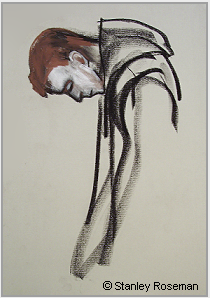
A Christmas Message from Queen Elizabeth II
on the Importance of Meditation and Prayer
on the Importance of Meditation and Prayer
Queen Elizabeth II delivered on Christmas Day 2013 her annual Christmas message with deeply meaningful words on the importance of meditation and prayer:
"We all need to get the balance right between action and reflection. With so many distractions, it is easy to forget to pause and take stock. Be it through contemplation, prayer, or even keeping a diary, many have found the practice of quiet personal reflection surprisingly rewarding, even discovering greater spiritual depth to their lives. . . .
"For Christians, as for all people of faith, reflection, meditation and prayer help us to renew ourselves in God's love, as we strive daily to become better people. The Christmas message shows us that this love is for everyone. There is no one beyond its reach."
Dom Simon at Vespers, 1999
Anglican Abbey of Elmore, England
Chalks on paper, 50 x 35 cm
Collection of the artist
Anglican Abbey of Elmore, England
Chalks on paper, 50 x 35 cm
Collection of the artist
An Ecumenical Work on the Monastic, or Contemplative, Life
Roseman's work on the monastic life, a life centered on contemplation and prayer, was begun in England in 1978. Over the years the artist's oeuvre grew to include some sixty-five monasteries in the British Isles and Continental Europe. This unprecedented and ecumenical work comprises communities of monks and nuns of the Roman Catholic, Anglican, and Lutheran faiths. Stanley Roseman is an artist of the Jewish faith.
The Prophet states in the Book of Psalms: ''At midnight I rise to praise you, O Lord" (Ps. 119:62) and "Seven times a day I praise you" (Ps. 119:164).
"I love the Lord, because he hath heard my voice and my supplications.
"Because he hath inclined his ear unto me,
therefore will I call upon him as long as I live.''
"Because he hath inclined his ear unto me,
therefore will I call upon him as long as I live.''
- from Psalm 116, sung at Vespers
From Roseman's sojourn at Elmore Abbey is the excellent drawing Dom Simon at Vespers, 1999, (fig. 3). The tall, red-headed, young Englishman is depicted standing reverently in choir.
The drawing of Dom Simon is rendered with vigorous, broad strokes of black chalk defining the monk's black cowl, with hood resting on his shoulders. His head is bowed deeply to his chest. His face in profile and with eyes closed is finely drawn and expresses an intense concentration. In this impressive drawing, the artist has effectively conveyed a young man's prayerful devotion to God.
3. Dom Simon at Vespers, 1999
Elmore Abbey, England
Chalks on paper, 50 x 35 cm
Collection of the artist
Elmore Abbey, England
Chalks on paper, 50 x 35 cm
Collection of the artist
Psalmody is the foundation of the Divine Offfice, the round of communal prayer that is central to the monastic life. Vigils, or the Night Office, is followed by the daytime Offices of Lauds and Prime in the early morning, Terce at mid-morning, Sext at midday, None in the early afternoon, Vespers in the early evening, and Compline at the end of the day.
The subjects in Roseman's paintings and drawings in monasteries in England range in age from young men making a commitment to the contemplative life to the oldest living monk in the twentieth-century Western Church: Dom Sylvester Mooney, Abbot Emeritus of Douai Abbey, who was 98 years old in 1984 and whose portrait in the British Museum is featured on Page 2 - "Returning to England Continued."
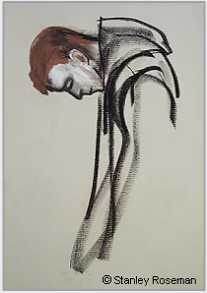
Roseman began his work on the monastic life in April 1978 at St. Augustine's Abbey, a Benedictine monastery in Ramsgate on the coast of Kent. After some twenty months of working in monasteries in the British Isles and on the Continent, the artist and his colleague Ronald Davis returned to England in December 1979. Abbot Gilbert Jones writes to Roseman and Davis: "I am full of admiration for your achievements and look forward so much to welcoming you back to Ramsgate.''
The Artist and the Benedictines
A selection of Roseman's paintings and drawings from St. Augustine's Abbey, along with the artist's remembrances of his first days in a monastery, are presented on the website page "From the Artist's Memoirs." Included are works in the Victoria and Albert Museum, London, and the Musée des Beaux-Arts, Rouen.
At Elmore Abbey, Berkshire
In 1987, the monks of Nashdom Abbey moved to a new location, near Newbury in Berkshire, and took up residence in the former Elmore House, which dates back to the early eighteenth century. Elmore Abbey constructed a beautiful, oak-framed chapel which was consecrated in 1995.
Roseman's sojourn at the Anglican Benedictine Abbey of Elmore in 1999 resulted in a suite of excellent drawings, which includes the present work Dom Francis, Portrait of a Benedictine Monk in Prayer, (fig 11).
The present work portrays Dom Francis in profile, his head lowered in prayer. In the portrait there is great sense of detail with minimal use of line and tone. Descriptive contours in bistre and black chalks are complemented by passages of bistre chalk, as in the rendering of the fringe of hair on the monk's head. Reserved areas of the gray paper enhance the monk's fair complexion, shading in bistre chalk adds warmth to the shadows, and highlights in white chalk illuminate the cranium and face of Dom Francis. Roseman has expressed in this beautiful portrait the man's dedication to the contemplative life.
11. Dom Francis,
Portrait of a Benedictine Monk
in Prayer, 1999
Elmore Abbey, England
Chalks on paper, 50 x 35 cm
Collection Ronald Davis
Portrait of a Benedictine Monk
in Prayer, 1999
Elmore Abbey, England
Chalks on paper, 50 x 35 cm
Collection Ronald Davis
The artist and his colleague had met Dom Francis at Nashdom Abbey in 1983. When they returned the following year, their friend had been recently appointed Prior, an appointment that the annual Nashdom Abbey Record, 1984, notes as "a decision which gave much pleasure outside the community as well as within it.''[4] Dom Francis' responsibilities in the Abbey were diverse and included those of infirmarian and organist as well as arranging receptions for special events, such as interfaith dialogues.
In a biographical essay on the artist, the Bibliothèque National de France praises Roseman for creating "an extensive oeuvre of chalk drawings profoundly expressive of the individual and the interior life.''[4]
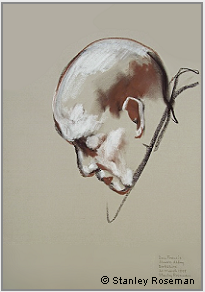
10. Abbot Godfrey in Prayer, 1984
Nashdom Abbey, England
Chalks on paper, 50 x 35 cm
Private collection
Nashdom Abbey, England
Chalks on paper, 50 x 35 cm
Private collection
Having drawn a portrait of Abbot Wilfrid the previous year, Roseman asked to also include in his work a drawing of Abbot Godfrey, the result of which is the beautiful drawing Abbot Godfrey in Prayer, 1984, (fig. 10). The Abbot is depicted seated in choir as he prays and meditates, his head inclined, his eyes lowered in reverence to God.
Roseman resumed his work at Nashdom Abbey the following year when he and Davis returned to England. Abbot Wilfrid had retired and the present abbot Dom Godfrey was equally enthusiastic for Roseman's work on the monastic life and warmly welcomed back the artist and his colleague for a third sojourn at Nashdom.
Roseman has rendered the Abbot's face with fine chiaroscuro modeling of the chalks. The warm shading in bistre chalk is complemented by luminous highlights on the monk's cranium, forehead, and cheek. Linear description in white chalk renders the hair and closely cropped beard. The Benedictine habit is drawn in calligraphic strokes and tonal passages of black and bistre chalks with reserved areas of the gray paper giving sheen to the black material.
Roseman's ecumenical work on the monastic life was greatly appreciated as expressed in thoughtful correspondence. Abbot Godfrey writes to the artist in receiving a Christmas gift in 1987 of a fine art print of the drawing Father Augustine in Choir, 1983, from the Roman Catholic, Trappist Abbey of Mellifont, in Ireland. The drawing had recently been acquired by the Dallas Museum of Art. Abbot Godfrey writes:
"Wishing you every blessing from God this coming year on your work and on your life.''
- Dom Godfrey Stokes, OSB
Abbot of Nashdom
Abbot of Nashdom
Nashdom Abbey Revisited
"Thank you so much for your great kindness in sending me your drawing of a monk from Mellifont Abbey. It was a very kind thought on your part and we are very happy to have it.
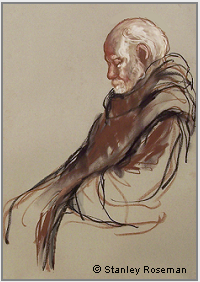
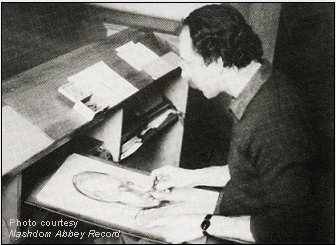
Benedictine monasticism in the Church of England dates from the nineteenth century with the emergence of several religious communities that adopted the Rule of St. Benedictine as the basis of a life of prayer and work. In 1914 a community of Anglican Benedictine monks was established in Pershore, Worcestershire. Some twelve years later, the monks resettled on a former private estate called Nashdom, in Buckinghamshire.
9. Roseman drawing in the choir of Nashdom Abbey.
At Nashdom Abbey, Buckinghamshire
Roseman and Davis were cordially received at Nashdom in 1983 by Abbot Wilfrid Weston and the monks. Abbot Wilfrid was of great encouragement to the artist and his colleague and invited them to share in the life of the community. "I concentrated much of my work in choir,'' recounts Roseman, "where I accompanied the monks when they gathered to chant the Psalms at the Divine Office, and I returned to choir with a monk to draw him in meditation and prayer.''
Photo courtesy Nashdom Abbey Record, Advent 1983.
Caption reads: "Stanley Roseman at Work."
Caption reads: "Stanley Roseman at Work."
Ushering in 1980 at St. Augustine's Abbey, Roseman drew the Benedictine monks in the year commemorating the 1,500 anniversary of the birth of Benedict of Nursia, the saintly Italian abbot whose rule, called the Rule of St. Benedict, is the basis of monastic observance in the Western Church. The Times, London, published in 1980 a superlative, full-length page review on Stanley Roseman's work on the monastic life:
''No one, I believe, in 1,500 years of Christian monachism has catalogued, defined
and described so clearly or so beautifully the business of the monastic life.
No writer, no sculptor, no painter, no architect has refined a distillation so pure,
so accurate, so breathtakingly clear as Roseman has done.''
and described so clearly or so beautifully the business of the monastic life.
No writer, no sculptor, no painter, no architect has refined a distillation so pure,
so accurate, so breathtakingly clear as Roseman has done.''
- The Times, London
The Bordeaux Museum of Fine Arts acquired Roseman's drawings on the monastic life and on the dance at the Paris Opéra, as well as on theatre productions in Paris and New York. In a cordial letter, Francis Ribemont, Chief Curator of Patrimony of the Musée des Beaux-Arts, Bordeaux, writes that Roseman's drawings "enrich the collection of 20th century drawings that are conserved in the museum'' and constitute "an ensemble of very great interest.''
A fascinating connection of history and events brings together Roseman's association with Farnborough Abbey and the Paris Opéra. Napoleon III commissioned the building of the new opera house, "Le Nouvel Opéra," also called the Palais Garnier after the name of its architect Charles Garnier. The splendid opera house, begun in 1862, was completed under the Third Republic and inaugurated in 1875.
8. Lyre and flute motif
on dance studio windows,
Paris Opéra, Palais Garnier.
© Photo by Ronald Davis
on dance studio windows,
Paris Opéra, Palais Garnier.
© Photo by Ronald Davis
The Emperor's Pavilion, a stately two-storied, architectural space in the Palais Garnier, today houses the Bibliothèque-Musée de l'Opéra, a branch of the Bibliothèque Nationale de France. On the gala occasion of the reopening of the Palais Garnier in March 1996, after eighteen months of renovation, the Bibliothèque Nationale de France presented "one hundred magnificent drawings from the artist's oeuvre on the dance'' in the exhibition Stanley Roseman - Dessins sur la Danse à l'Opéra de Paris.[3] (See "Biography,'' Page 6 - "Drawings on the Dance at the Paris Opéra.'')
The Abbot of Solesmes Dom Jean Prou speaks in a meaningful letter about the relationship between Roseman's drawings on the dance and his work on the monastic life. The letter is quoted on "Correspondence from the Monasteries" - Page 2.
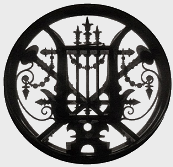
The Rule of St. Benedict allocates Chapters 8 through 18 to the celebration of the Divine Office. The chapters include instructions on the arrangement and number of Psalms for each office of the day and night. Chapter 19 concerns the discipline of Psalmody.
A Selection of Portraits of Benedictine, Trappist, and Carthusian monks
whom Roseman drew on his return to monasteries in England.
Drawings of Monks at Vigils, Lauds, and Compline.
whom Roseman drew on his return to monasteries in England.
Drawings of Monks at Vigils, Lauds, and Compline.
1. The Rule of St. Benedict English translations by Abbot David Parry, O.S.B., Households of God, (Darton, Longman &Todd, London, 1980).
2. David Higham, O.S.B., History and Guide - St. Michael's Benedictine Abbey - Farnborough, (Farnborough, Hampshire, 1978), pp. 2, 3, 4, 13.
3. Stanley Roseman - Dessins sur la Danse à l'Opéra de Paris (text in French and English),
(Paris, Bibliothèque Nationale de France, 1996), p. 11.
4. Nashdom Abbey Record, (Buckinghamshire, Nashdom Abbey, 1984), p. 6.
2. David Higham, O.S.B., History and Guide - St. Michael's Benedictine Abbey - Farnborough, (Farnborough, Hampshire, 1978), pp. 2, 3, 4, 13.
3. Stanley Roseman - Dessins sur la Danse à l'Opéra de Paris (text in French and English),
(Paris, Bibliothèque Nationale de France, 1996), p. 11.
4. Nashdom Abbey Record, (Buckinghamshire, Nashdom Abbey, 1984), p. 6.